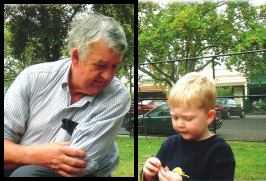
Curated with aloha by
Ted Mooney, P.E. RET

The authoritative public forum
for Metal Finishing 1989-2025

-----
Formation of manganese oxides
I'm doing research on thin films. I aimed at preparing MnO2 thin films by spray pyrolysis using a precursor of manganese acetate+100%ethanol at a spraying temp. of 400 degrees. But I ended up in getting Mn3O4 films which were confirmed by XRD. I want to know the reason for that?
Sally Fletcherstudent - Tamilnadu, India
April 10, 2008
Essentially, too much oxygen in the reaction environment, so you get the more highly oxidised trimanganic tetroxide instead of the manganese dioxide you are seeking.
Find a way of lowering the oxidising activity of the reaction environment.

Bill Reynolds [deceased]
consultant metallurgist - Ballarat, Victoria, Australia
We sadly relate the news that Bill passed away on Jan. 29, 2010.
April 12, 2008
Mn3O4 is a mixture of MnO2 and MnO; that is, the manganese in in two oxidation states, 2 and 4. What you want is MnO2, which is pure Mn(IV).
MnO2 is a powerful oxidising agent and is unstable at high temperatures. When heated, it will liberate oxygen to give Mn(II).
Whilst I am not familiar with your reaction, I suspect the manganese dioxide (if it is indeed formed by your reaction) is reacting with the ethanol to oxidise it to acetaldehyde (CH3CHO) and even acetic acid (CH3COOH).

Trevor Crichton
R&D practical scientist
Chesham, Bucks, UK
April 18, 2008
You're right, Trevor, and I was wrong - I had my oxidation numbers around the wrong way. Note to self - stick to metallurgy and leave chemistry to chemists, and be very careful in areas where the two disciplines overlap!
My apology to the OP - I hope she wasn't inconvenienced by my mistake.

Bill Reynolds [deceased]
consultant metallurgist - Ballarat, Victoria, Australia
We sadly relate the news that Bill passed away on Jan. 29, 2010.
April 21, 2008
Bill, I am a chemist that specialised in industrial metallurgy. However, I consider myself a better chemist than metallurgist (it is also easier to spell!). Have a good one.

Trevor Crichton
R&D practical scientist
Chesham, Bucks, UK
April 23, 2008
Q, A, or Comment on THIS thread -or- Start a NEW Thread